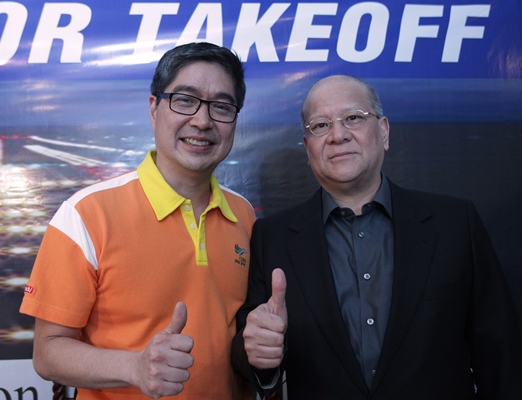
Cebu Pacific Air President Lance Gokongwei (left) and Philippine Airlines President Ramon S. Ang give a thumbs up sign during the press briefing announcing the US Federal Aviation’s upgrade of the Philippine air safety ranking. (AP)
PHILIPPINE Airlines may save as much as $160 million a year once it starts replacing its aging fleet of Boeing 747 planes now serving lucrative United States routes, company president Ramon S. Ang said.
The flag carrier is looking to acquire newer, more fuel-efficient planes to stem its financial losses.
The announcement came a day after the United States Federal Aviation Authority said it would bring the Philippines back to the so-called Category 1 aviation status, which would open up the United States to local carriers.
Rival carrier Cebu Pacific said it was studying European destinations like London, Paris and Amsterdam, apart from US destinations such as Hawaii, Guam and Saipan, CEO Lance Gokongwei said on Thursday.
In the case of Philippine Airlines, which already flies to the United States, the immediate benefit of a Category 1 rating is that it can now avail of newer Boeing 777 planes as the US “blacklist” has been finally lifted after six years.
Its previous Category 2 rating prevented the national carrier from acquiring newer aircraft, as well as expanding routes beyond existing destinations.
“This means at least $100 million a year on savings on fuel, and another $60 million on maintenance,” Ang said in press conference, where it was announced that a European Union ban was lifted for Cebu Pacific, the country’s biggest budget carrier and a rival of Philippine Airlines.
PAL uses the Boeing 747-400 aircraft to ferry passengers to Los Angeles and San Francisco.
Once Boeing’s best-selling model, the 747-400 model will be replaced, PAL can save on costs since the more efficient Boeing 777s have enough range to reach the US east coast from Manila.
The Philippine Airlines, however, obtained its first Boeing 777-300ER in 2009, a year after the US FAA downgraded the Philippines to Category 2. The flag carrier currently has a fleet of six Boeing 777-300s, which Ang said would be deployed to the United States “within a month’s time.”